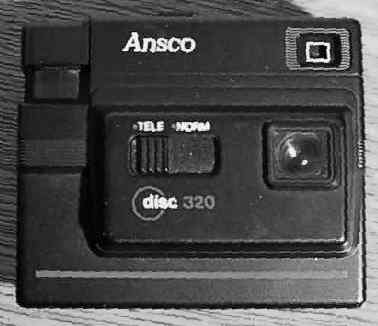
ANSCO DISC CAMERAS

This list is inaccurate and incomplete. Typically, these cameras were very simple and specifics were never listed by the manufacturer. Since so many styles and types were made, it is impossible to list them all. If you are able to provide more accurate information than is listed here, please contact us.
See CADET disc 100 (below).
12.5mm (f4.0) fixed focus lens. Settings for sunny, cloudy or flash (Magi-cube) conditions. The switch on the front also covers the lens & locks the shutter. No battery needed.
12.5mm fixed focus lens.
12.5mm (f4.0) and 25mm (f6) fixed-focus lenses. The lens selector switch also changes the view in the finder. There were two versions of this camera -- the first one has a flip-flash connection, while the later model had a hot shoe for an electronic flash. No battery needed.
Simplified version of the HR 30.
Normal and Tele lenses.
Dual lens camera.
Dual lens camera with built-in flash and motor drive. The front of the camera can be used as a cover or a handle. The best or the worst of the disc cameras -- depending on who you ask. It it full-featured but is as big as some 35mm cameras, like the Konica AA-35 half-frame. It's the same as the Hanimex 620, Boots Tele Disc 715 -- and probably others.
The Cadet disc 100 is a Memo Disc HR 10 (below) with a hot shoe instead of a flip-flash connection -- and in snappy colors like blue, yellow and red. The Cadet was so inexpensive that there were also many promotional Cadet disc 100 cameras made, such as the Cadet disc 100 with "Budweiser" on it , the Coca-Cola Cadet, and the Cadet 100 with " Beefeater Gin" on it. A special hot-shot flash, the Ansco-lite F20, was available.
See Cadet disc 100
Snappy colors and a tele lens
12.5mm (f4.0) fixed focus lens. An ultra-compact, take-anywhere design, it accepts a flip-flash. No battery needed.
Not as small as the original HR 10, it has a photo cell that changes the shutter speed -- and actually cost less in 1985 ($17) than the original ($19). Go figure. Same 12.5mm (f4.0) fixed focus lens.
You guessed it, it's the same 12.5mm (f4.0) fixed focus lens, but this model has a built-in electronic flash. It was listed as having aperture-priority exposure control. It does in the sense that the f-stop is set at f2.8 when the flash is used, and stops down to f6 when it's not. Uses 2 AAA batteries.
Uses 2 AA batteries.
12.5mm (f2.8) fixed focus lens. Built-in electronic flash and motor drive. Uses 2 AA batteries.
12.5mm (f2.8) fixed focus lens. Aperture-priority automatic exposure. Built-in electronic flash, close-up lens and motor drive. Uses 1 9-volt battery.
Telephoto, fixed-fixed focus lens. Aperture-priority automatic exposure. Built-in electronic flash, close-up lens and motor drive. Uses 2 AA batteries.
Telephoto, fixed-fixed focus lens. Aperture-priority automatic exposure. Built-in electronic flash, close-up lens and motor drive. Uses 2 AA batteries.

To return to the main index for the Sub Club click here.
COPYRIGHT @ 1995, 1996, 1997, 1998, 1999, 2000, 2001, 2002, 2003, 2004, 2005 by Joe McGloin. All Rights Reserved.